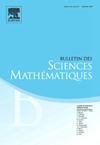仙人掌群的最小表示、有限商和下中心序列
IF 0.9
3区 数学
Q2 MATHEMATICS, APPLIED
引用次数: 0
摘要
本文从组合学的角度对仙人掌群进行了研究。这些群最近在数学的各个领域都得到了突出的表现,其中包括它们与众所周知的群的关系,如辫群、图群等。我们计算了仙人掌群在生成器和非冗余关系方面的最小表示。我们还构造了这些群在某些有限群上的同态,得到了仙人掌群有限商的结果。更确切地说,我们构造了普适Coxeter群上的同态,并证明了所有(无限)二面体群都是仙人掌群的商。这进一步方便了下中心级数及其连续商的研究。虽然已经有已知的与辫子组的相似之处,但我们推断出两组之间存在相当大的差异。本文章由计算机程序翻译,如有差异,请以英文原文为准。
Minimal presentation, finite quotients and lower central series of cactus groups
This article deals with the study of cactus groups from a combinatorial point of view. These groups have been gaining prominence lately in various domains of mathematics, amongst which are their relations with well-known groups such as braid groups, diagram groups, to name a few. We compute a minimal presentation for cactus groups in terms of generators and non-redundant relations. We also construct homomorphisms of these groups onto certain finite groups, which leads to results about finite quotients of cactus groups. More precisely, we construct homomorphisms onto the universal Coxeter group and prove that all (infinite) dihedral groups appear as quotients of cactus groups. This further facilitate the investigation of the lower central series and its consecutive quotients. While there are already known established similarities with braid groups, we deduce a considerable disparity between the two groups.
求助全文
通过发布文献求助,成功后即可免费获取论文全文。
去求助
来源期刊
CiteScore
1.90
自引率
7.70%
发文量
71
审稿时长
6-12 weeks
期刊介绍:
Founded in 1870, by Gaston Darboux, the Bulletin publishes original articles covering all branches of pure mathematics.

 求助内容:
求助内容: 应助结果提醒方式:
应助结果提醒方式:


